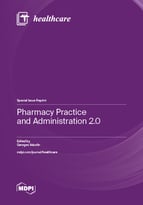Pharmacy Practice and Administration 2.0
A special issue of Healthcare (ISSN 2227-9032). This special issue belongs to the section "Medication Management".
Deadline for manuscript submissions: closed (1 November 2023) | Viewed by 22071
Special Issue Editor
Interests: pharmacoeconomics; health outcomes research; pharmacy pricing and reimbursement; cost analysis
Special Issues, Collections and Topics in MDPI journals
Special Issue Information
Dear Colleagues,
We invite you to submit a manuscript to the “Pharmacy Practice and Administration 2.0” Special Issue in the journal Healthcare—an open access journal with a focus on healthcare systems, industry, technology, policy, and regulation.
The scope of this Special Issue is research and reviews on evaluations of current practice, innovations in medication management, developments in therapeutics, and pharmaceutical science research that informs and improves practice and administration as well as the social and administrative pharmacy. We will mainly feature original research, reviews, short reports, and clinical studies, but will also welcome case reports, descriptive/how-to, and commentary submissions for consideration.
Topics of interest include, but are not limited to, the following:
- Pharmacy-based medication management;
- Pharmacy law and regulation;
- Pharmacy business management;
- Pharmacy education;
- Pharmacoeconomic;
- Quality assurance;
- Pharmacoepidemiology;
- Quality-of-life studies;
- Epidemiology;
- Patient satisfaction.
Please note that a special consideration has been negotiated with the publishers that if the Special Issue publishes more than 10 papers, the publisher will print a book edition. The book will be available in both digital and printed formats for order.
Dr. Georges Adunlin
Guest Editor
Manuscript Submission Information
Manuscripts should be submitted online at www.mdpi.com by registering and logging in to this website. Once you are registered, click here to go to the submission form. Manuscripts can be submitted until the deadline. All submissions that pass pre-check are peer-reviewed. Accepted papers will be published continuously in the journal (as soon as accepted) and will be listed together on the special issue website. Research articles, review articles as well as short communications are invited. For planned papers, a title and short abstract (about 100 words) can be sent to the Editorial Office for announcement on this website.
Submitted manuscripts should not have been published previously, nor be under consideration for publication elsewhere (except conference proceedings papers). All manuscripts are thoroughly refereed through a single-blind peer-review process. A guide for authors and other relevant information for submission of manuscripts is available on the Instructions for Authors page. Healthcare is an international peer-reviewed open access semimonthly journal published by MDPI.
Please visit the Instructions for Authors page before submitting a manuscript. The Article Processing Charge (APC) for publication in this open access journal is 2700 CHF (Swiss Francs). Submitted papers should be well formatted and use good English. Authors may use MDPI's English editing service prior to publication or during author revisions.
Keywords
- COVID-19
- pharmacy administration
- pharmacy management
- pharmacoeconomics
- cost effectiveness
- cost analysis
- cost benefit
- social and behavioral pharmacy
- health outcomes
- Pharmacist-based medication management
- Pharmacy practice
- Pharmacy technicians' support
- Pharmacy law and regulation
- Innovation







